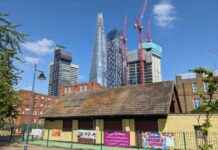Restoring Wetlands: Revitalizing a Stolen Ecosystem
In a remarkable display of community effort and environmental dedication, volunteers have banded together to repair the damage caused by years of thefts of water filtering equipment along the Lea River. The once-thriving wetland habitat of the historic Middlesex filter beds has been restored in a two-year project aimed at returning the nature reserve to its former glory.
The restoration initiative, spearheaded by the Lee Valley Regional Park Authority in collaboration with conservation experts and civil engineers, marks a significant step towards reclaiming the lost wetland next to Lea Bridge Road. Paul Roper of the Lee Valley Regional Park emphasized the importance of restoring these dynamic ecosystems, which are among the most threatened habitats in the world. With global warming, pollution, and urbanization taking a toll on wetlands across Britain, the need to preserve and revive these critical habitats has never been more pressing.
Enhancing Biodiversity in Urban East London
The restoration of the Middlesex filter beds is not just a local endeavor but a broader effort to increase biodiversity in this green corner of urban east London. By bringing back amphibians such as frogs, toads, and newts, as well as attracting dragonflies and birds to the filter beds, the Lee Valley Regional Park Authority aims to create a thriving ecosystem that benefits both wildlife and the local community. As the wetlands flourish once again, the hope is to see a resurgence of diverse plant and animal species that call this unique habitat home.
The long-term aim of the restoration project is to have water flowing back into the filter beds, a goal that was impeded by repeated thefts of equipment that caused the water supply from the Lea to dry up six years ago. Originally built in the 1860s following a devastating cholera outbreak in east London, the filter beds played a crucial role in purifying the city’s water supply. However, as population growth and increased demand for clean water led to the construction of new treatment works at Walthamstow, the old filter beds fell into disuse and were eventually abandoned in 1969.
Overcoming Challenges and Achieving Success
Efforts to maintain the filter beds as a wetland for wildlife faced numerous challenges, including the spiraling costs associated with the theft of essential equipment needed to keep the water flowing. The Lee Valley Regional Park Authority, in partnership with Pick Everard civil engineers, devised a solution to develop secure pumping systems that would ensure a continuous water supply to the filter beds. This innovative approach not only addressed the theft issue but also laid the foundation for the successful restoration of the wetland habitat.
The restoration project was made possible through the dedication and hard work of volunteers from various organizations, including Lee Valley Regional Park, Clapton Green Gym, Lea Bridge Conservation, and Haggerston Gardeners. Under the guidance of the authority’s park ranger and conservation teams, these volunteers spent months clearing the scrubland to create a conducive environment for native flora and fauna to thrive. Already, there are early signs of returning wildlife along the 26 miles of the Lea Valley, indicating the positive impact of the restoration efforts.
In conclusion, the restoration of the Middlesex filter beds stands as a testament to the power of community collaboration and environmental stewardship. By overcoming challenges and working together towards a common goal, volunteers and experts have succeeded in revitalizing a stolen ecosystem and creating a sustainable habitat for future generations to enjoy. As wetlands continue to face threats from human activities, initiatives like this serve as a beacon of hope for the preservation and restoration of these vital ecosystems.





















